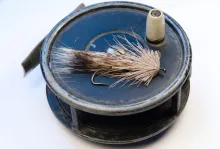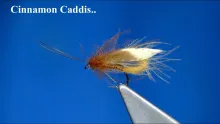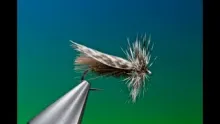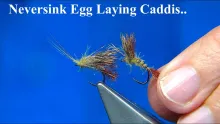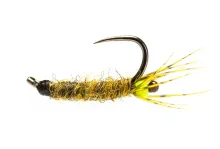... and then there's deer hair. And it can be many different things. It is not at all that easy to find the right kind for the many patterns with this fantastic material
the member magazine for the Federation of Fly Fishers Denmark.
When I started tying flies many years ago, I started the hard way. I had had success with some muddlers which a fellow angler had given me, and I wanted more.
In the local flyshop they said: "We don't have muddlers. Tie your own!”
I left with my first vise, hooks, thread, bobbin holder, orange marabou and black deer hair – probably the least muddler-friendly deer hair I've ever owned!
I learned the deer hair lesson the hard way, and my first muddlers were miserable to say the least.
It was probably primarily due to my total lack of experience, but also due to the fact that I had been equipped with some hair that was in no way suitable for tying muddlers.
This article is not about how to use deer hair and does not cover any techniques, like actually tying muddlers, packing dense deer hair bodies or making good caddis wings.
It is about choosing the deer hair that makes the techniques work.
I may return to the techniques some other time.
Martin Joergensen
What is deer hair?
Well, the simple answer is that it is hair from deer! The truth is, however, that it is somewhat more complicated than that, because a deer is not just a deer, and there are many different types of hair on a deer.
Here i Denmark, where I live, and in most of Europe, we are usually talking about red deer, fallow deer and roe deer when we talk about deer. Sikas are also common in Europe, although introduced from Asia, like the rarer muntjak and water deer. Other deer species are reindeer and moose, which can also be used in fly tying.
Materials labeled as deer hair for fly tying can be anything from African antelopes (which aren't actually deer) to American elk or whitetails. The most common, however, is that the hair we buy for fly tying comes from elk, whitetail or fallow deer.
We buy the hairs on the skin, and often in relatively small pieces of maybe 5 by 5 or 10 by 10 cm (2 or 4 inch squared). The hide is dried or tanned. It doesn't make much of a difference. In some cases, it is clear from the package what species it is and where on the animal the hair comes from, and perhaps even what it is suitable for. Other times it is completely unclear, and it just says "deer hair" on the bag.
It is best to know which animal it is, and from where on the skin it's taken, because this has a great influence on the use. If it's perfect you also know what time of year the animal was shot, because the season has an influence on the character of the fur. Read this article by the late Chris Helm, a true master of deer hair. His article also covers a lot of the subjects mentioned here.
What's found where?
There are, of course, differences between the many species of deer, but if we take the slightly larger ones such as elk, whitetail, red deer and fallow deer, the hairs are roughly distributed like this on the animals' bodies:
Mask (1)
- short hair, medium thickness, small dry flies and caddis flies, Comparadun and other dry flies where the hairs have to spread.
Back (2)
- medium length hairs, fine but dense, suitable for wings on wet flies and small streamers. Doesn't float that well.
Body (3)
- medium length hair, medium fine to thick. Good for small muddlers, grasshoppers, Humpy, Elk Hair Caddis, CDC&Elk. Good buoyancy.
Back (rump) and belly (4)
- long, often thick hair. Good for large deer hair flies (muddlers, bass bugs, mice and the like). Good buoyancy. The white belly hairs are suitable for dyeing.
Legs (5)
- relatively short and fine hair. Good for smaller caddis flies.
Tail - AKA bucktail (6)
- very long, dense. Good for streamers, saltwater flies, pike flies. Doesn't float that well.
The lengths above are relative. The hair on a whitetail is naturally longer than the hair on a roe deer, which is a significantly smaller animal.
What's the difference?
When we talk deer hair, many think of rather thick and porous hair. The hairs are porous because they have air in them. They are not hollow, but rather "spongy" with small air pockets. The air helps the animals keep warm.
The character of the hair changes with the season, and is both longer and more air-filled in the winter and denser and shorter in the summer. The major disadvantage of the winter coat, however, is that there is also plenty of “woolly” underfur, and that will get in the way when the hair is used, and will have to be removed.
The animals have the optimal fur in the autumn when we look at it from the perspective of the fly tyer. The thicker winter coat has set and is "fresh" and unbroken, but the dense underfur has not yet developed.
The usefulness of the hair as a tying material depends on its length, thickness and how dense it is.
If you want to tie muddlers or other flies with densely packed bodies, like mice or bass bugs, the hair should ideally be thick, soft and air-filled. That is best suited for spinning and compressing. That is groups 3 and 4 above.
If we are to make wings on dry flies, the hairs must be short to medium length and not too airy. If they are, the wings will flare because the hairs spread too much under the pressure of the thread. It could come from groups 1, 2 and 5 above.
If it's wings or bodies of streamers, saltwater flies or pike flies that are the target, then the "hard" (not so airy) and long hair is the best. That basically does not flare under the pressure of the tying thread, and will be easier to control. In addition, the length can produce large flies, and the long hairs have good mobility when wet, which is often desirable. It is primarily tail hair, group 6 above. Some hairs from the middle and sides of the back are also good for smaller flies or as "support" under softer wings of such as zonker strips or Arctic fox. They can come from group 2 or some of the shorter tail hairs in group 6.
The length of the hair
The length of the hairs must suit the purpose, and it's not a good idea to shorten long hairs and use them where short hairs are needed like for wings on dry flies. The tips are often shiny and dense, and behave differently from the very base of the hair. In addition, there are fine color patterns in the length of the hair, which can be lost if they are trimmed too much.
On the other hand, the tips are not used at all on muddlers and spun flies, where most of them are typically cut off. Here, the base of the hair should ideally be uniform and long, and preferably thick and soft. This part of the hair is often completely dull, and if the hair is shiny and smooth, it's often a sign that it is not suitable for spinning.
Be selective, be picky
As you can probably see, it is not enough to just say "deer hair" to your dealer, or search for "deer hair" on the internet, and then fill the shopping basket.
You may be lucky to get something useful, but if you want to be certain, you should preferably have your hands on the material so that you can assess it. You can also be lucky to find something where there is an specification of use on the package or in the description. That may allow you to find something useful without having had it in your hands.
There is a colossal difference in quality - and here we are talking about good or bad. Some hair is dry, curly, has broken tips, is dirty and maybe even uneven on the skin piece because it is just cut in a random place on the animal.
Other pieces of skin are have nice, clean, uniform and straight hairs, without dirt or underfur, and is ready to use straight out of the bag.
Dyed deer hair
If you want to tie some funky flies with some color, then you need to get hold of some dyed deer. Deer hair can be found in the most fantastic colors, and when it's the white hair from the belly of the animals that is dyed, there are almost no limits to the shades. Shocking pink, orange, screaming yellow and other almost luminescent colors are not rare. The dyeing process will often curl the skin, but the hair can easily be used for spinning anyway. A little steam can, as mentioned below, tame it a bit, and oftentimes the curly hair will straighten out just fine.
Bucktail is also available in a very large range of colors, and as part of the deer tail is naturally white, the dyeing is mostly really good.
For the smaller dry flies, there are more natural colors to be found, like olive or brown shades and hair that has been bleached to light, sandy tones.
Be aware that bleaching can be tough on the material, and that bleached hair is often drier and more delicate than natural hair.
Prepare the hair before tying
Steam is your friend! Most deer hair really benefits from a trip into the steam from a boiling kettle of water. The steam causes the hairs to straighten in their natural shape, and will make it much easier to find and cut the right bundle for your purpose.
You can find hair that is so well prepared straight out of the bag that this isn't necessary, but most deer skin patches still benefit from some steam.
When cutting material, remove any underfur. Use a comb, a dubbing needle or your fingers. Grab the tips firmly and then comb or pull the wool out at the butts.
If you need to use the tips for a collar on a muddler or the wing of a caddis, then use a hair stacker to even the hairs. Put the hairs into the stacker with the tips first and then tap it against a table top. This process is much easier if the hairs are clean, straight and free of underfur.
You will get better
It may well be that having proper materials does not automatically make you a better fly tyer, and your muddlers will not be perfect just because you have the perfect deer hair. It still requires proper technique, practice and routine.
But there is no doubt that you tie worse flies if the materials are not good, and if you are a beginner, then good materials makes it much easier to improve.
Hand picked for this article
- Log in to post comments













